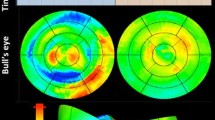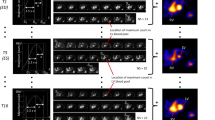Abstract
Ejection fraction and ejection rate are easily obtained from gated cardiac images, but no method is available for calculating mean circumferential fiber shortening rate. We assumed that the cube root of left ventricular end-diastolic volume or counts is proportional to the minor axis of the left ventricle at end-diastole or end-systole. Mean circumferential fiber shortening rate is then equal to the [cube root of the end-diastolic volume (count) minus cube root of end-systolic volume (count)] divided by [cube root of end-diastolic volume (count) multiplied by the ejection time]. In 250 contrast ventriculograms, the standard mean circumferential fiber shortening rate (MCFSR) and that derived by the cube root method correlated well (r=0.94). The mean value of MCFSR (0.85±0.35) was greater than the cube root value (0.75±0.35) (P<0.001). The regression equation was y=0.86x+0.02. Similar correlations were obtained from gated radionuclide images using a semiautomated program (r=0.93) in 24 subjects or completely automated program (r=0.85) in 28 patients. The regression equation between MCFSR and that derived from the cube root of counts for the semiautomated program was y=0.82x+0.04 and for the automated program was y=0.84x+0.004. Similar correlations, slopes, and intercepts were seen using circumferential fractional shortening for angiographic data when correlated with both the semiautomated and automated gated blood pool scan programs. These data indicate that MCFSR and circumferential fractional shortening may be obtained from gated blood pool images using cube root estimates of end-diastolic and end-systolic radii with a high degree of correlation with the standard contrast ventriculographic technique.
Similar content being viewed by others
References
Ashburn WL, Schelbert HR, Verba JW (1978) Left ventricular ejection fraction. A review of several radionuclide angiographic approaches using the scintillation camera. Prog Cardiovasc Dis 20:267–284
DeMaria A, Neuman A, Schubert P, Lee G, Mason D (1979) Systematic correlation of cardiac chamber size and ventricular performance determined with echocardiography and alterations in heart rate in normal subjects. Am J Cardiol 43:1
Fortuin, N, Hood W, Craige E (1972) Evaluation of left ventricular function by echocardiography. Circulation 46:26–35
Karliner JS, Gault JH, Eckberg D, Mullins B, Ross J Jr (1971) Mean velocity of fiber shortening. Circulation 44:323–333
Mahler F, Yoran C, Ross J Jr (1974) Inotropic effects of tachycardia and post-stimulation potentiation in the conscious dog. Am J Physiol 227:569
Mahler F, Ross J Jr, O'Rourke R, Covell J (1975) Effects of changes of preload, afterload and inotropic state on ejection and isovolumic phase measures on contractility in conscious dogs. Am J Cardiol 35:676–842
Qureshi S, Wagner H, Alderson P, Housholder D, Douglass K, Lotter M, Nickoloff E, Tanabe M, Knowles L (1978) Evaluation of left ventricular function in normal persons and patients with heart disease. J Nucl Med 19:135–141
Ricci D, Orlick A, Alderman E, Ingels N, Daughters G, Kusnik C, Reitz B, Stinson E (1979) Role of tachycardia as an inotropic stimulus in man. J Clin Invest 63:695
Slutsky R, Karliner J, Ricci D, Kaiser R, Pfisterer M, Gordon D, Peterson K, Ashburn W (1979) Left ventricular volumes calculated by gated radionuclide angiography: A new method. Circulation 60:556–565
Slutsky R, Karliner J, Battler A, Peterson K, Ross J Jr (1980) Comparison of early systolic and holosystolic ejection phase indices by contrast ventriculography in patients with coronary heart disease. Circulation 61:1083–1090
Slutsky R, Pfisterer M, Verba J, Ashburn W (1980) Equilibrium radionuclide angiography: influence of different background and left ventricular assignments on ejection fraction results. Radiology 135:755–761
Slutsky R, Watkins J, Peterson K, Karliner J (1981) The response of left ventricular function and size to atrial pacing, volume loading and afterload stress in patients with coronary artery disease. Circulation 60:864–870
Steele P, Lefree M, Kirch D (1976) Measurement of left ventricular mean circumferential fiber shortening velocity and systolic ejection rate by computerized radionuclide angiocardiography. Am J Cardiol 37:388–393
Author information
Authors and Affiliations
Additional information
Supported by the Medical Research Service of the Veterans Administration Medical Center and NIH Research Grant HL 17682, awarded by the National Heart, Lung and Blood Institute
Rights and permissions
About this article
Cite this article
Bhargava, V., Costello, D., Slutsky, R. et al. A method for measuring mean circumferential fiber shortening rate from gated blood pool scans. Eur J Nucl Med 7, 6–10 (1982). https://doi.org/10.1007/BF00275236
Received:
Issue Date:
DOI: https://doi.org/10.1007/BF00275236




